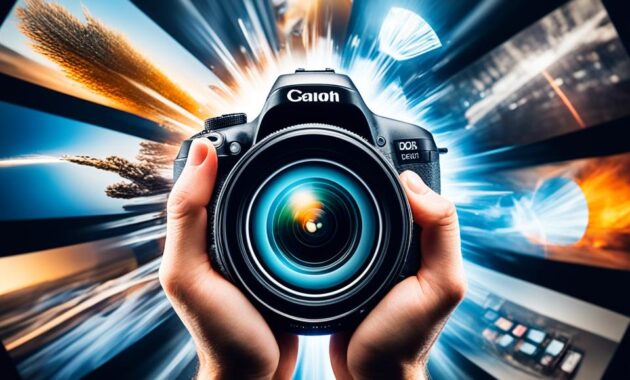Welcome to the captivating world of photography, where capturing moments and telling stories through the lens is an art form. This guide is for both beginners and experienced photographers. It will provide you with the essential tips and techniques to improve your skills. Get ready for a journey of creativity, innovation, and a deeper appreciation for photography.
This article will cover the technical aspects of exposure, composition, and lighting. It will also help you unleash your creative potential. Discover the secrets that will help you capture stunning, awe-inspiring images. Whether you’re shooting landscapes, portraits, or everyday moments, this guide will give you the knowledge and inspiration to enhance your photography.
Key Takeaways
- Explore the fundamental principles of photography, including aperture, shutter speed, and ISO.
- Learn techniques for composing captivating shots and leveraging natural and artificial lighting.
- Discover the art of storytelling through your photography and develop a keen eye for capturing unique moments.
- Understand the differences between DSLR and mirrorless cameras, and choose the right lenses for various photography genres.
- Dive into the world of post-processing and master the techniques to enhance your images.
Mastering the Fundamentals of Photography
For those aiming to excel in photography, understanding the core elements is essential. This section will explore the fundamental principles of photography. We’ll focus on the exposure triangle – aperture, shutter speed, and ISO. Additionally, we’ll discuss techniques for composing captivating shots.
Understanding Exposure: Aperture, Shutter Speed, and ISO
The exposure triangle forms the basis of photography. Grasping how these elements interact is crucial for achieving the desired look in your images. Aperture regulates the light entering the camera. Shutter speed controls the duration of light exposure. ISO adjusts the camera’s light sensitivity, enabling photography in various lighting scenarios.
By understanding the interplay between aperture, shutter speed, and ISO, you can control exposure, depth of field, and motion blur. These elements significantly impact the aesthetic and impact of your photographs.
Composing Captivating Shots
Composition is the art of arranging elements within the frame to create engaging and meaningful images. Techniques like the rule of thirds, leading lines, and framing can enhance your composition.
Knowledge of composition allows you to guide the viewer’s eye, evoke emotions, and tell a story through your images. Experiment with different approaches to see how they influence your photographs’ impact and storytelling.
| Aperture | Shutter Speed | ISO |
|---|---|---|
| Controls the amount of light entering the camera | Determines the duration of light exposure | Adjusts the camera’s sensitivity to light |
| Affects depth of field | Freezes or blurs motion | Allows for capturing images in various lighting conditions |
“Photography is the art of observation. It has little to do with the things you see and everything to do with the way you see them.” – Elliott Erwitt
Unleashing Your Creativity with Lighting
Lighting is crucial in photography, opening up a realm of creative potential. Whether you’re shooting landscapes or portraits, knowing how to use natural and artificial light can transform your work. This knowledge is key to enhancing your photography skills.
Natural Light Photography
The sun is the ultimate source of natural light, offering a variety of moods and atmospheres. From the warm hues of sunrise to the soft light of an overcast day, natural light is versatile. By experimenting with its direction, quality, and intensity, you can create images that stir emotions and add depth.
Artificial Lighting Setups
Artificial lighting takes over when natural light isn’t sufficient, providing control and flexibility. Try out different setups like softboxes, umbrellas, and studio strobes to find the perfect lighting for your subject. Learn how to balance various light sources, manipulate shadows, and create dramatic effects to elevate your photography.
| Natural Light | Artificial Lighting |
|---|---|
|
|
Embrace the power of lighting to unlock your creative potential. Whether you lean towards the natural beauty of natural light or the artistic control of artificial lighting, the secret to stunning photography is in your ability to manipulate and harness light.
“The best lighting is the lighting that serves the story.” – Martin Scorsese
Exploring Different Photography Genres
The world of photography is vast and diverse, offering endless opportunities for creative expression. It ranges from the captivating world of portraiture to the sweeping grandeur of landscape photography. Each genre presents unique challenges and rewards. This section will explore the distinct characteristics of various photography genres. It aims to help you find your niche and develop a signature style.
Portraiture: Capturing the Essence of the Subject
Portraiture delves into the heart of the human experience, revealing the subject’s personality, emotions, and inner world. Whether you prefer classic studio shots or candid street scenes, mastering portraiture requires an understanding of lighting, composition, and connecting with your subject.
Landscape Photography: Painting with Light and Perspective
Nature offers a breathtaking canvas for landscape photographers. From sweeping vistas to intimate details, capturing the essence of nature requires a keen eye for light, composition, and conveying the grandeur and serenity of the outdoors.
Nature and Wildlife Photography: Capturing the Untamed
Exploring nature and wildlife photography is thrilling, as you aim to immortalize the raw beauty and untamed spirit of the natural world. Patience, stealth, and understanding animal behavior are key to success in this field.
Macro Photography: Revealing the Extraordinary in the Ordinary
Macro photography invites us to explore the intricate details of the world, unveiling hidden wonders. By magnifying small subjects, macro photographers create captivating images that transport viewers into a world of extraordinary beauty.
Street Photography: Capturing the Pulse of the City
Street life offers a rich tapestry for photographers. By navigating the urban landscape with a keen eye and quick reflexes, street photographers capture spontaneous moments, quirky characters, and candid interactions that define everyday life.
As you explore these diverse genres, remember that the true beauty of photography lies in your unique perspective and sharing your vision with others. Embrace challenges, experiment with techniques, and let your passion guide you on a journey of creative exploration.
| Photography Genre | Key Characteristics | Technical Considerations |
|---|---|---|
| Portraiture | Capturing the essence and personality of the subject | Lighting, composition, connection with subject |
| Landscape | Conveying the grandeur and serenity of the natural world | Light, perspective, composition |
| Nature and Wildlife | Immortalizing the raw beauty and untamed spirit of the natural kingdom | Patience, stealth, understanding of animal behavior |
| Macro | Revealing the extraordinary in the ordinary through magnification | Specialized equipment, attention to detail |
| Street | Capturing the spontaneous moments and candid interactions of urban life | Quick reflexes, adaptability, eye for the unexpected |
“Photography is a way of feeling, of touching, of loving. What you have caught on film is captured forever… it remembers little things, long after you have forgotten everything.”
– Aaron Siskind
Choosing the Right Camera and Lenses
Choosing the right camera and lenses is vital for your photography journey. Whether you lean towards the traditional DSLR or the modern mirrorless technology, it’s essential to grasp the differences between them. This knowledge will aid in making a choice that matches your photographic ambitions and needs.
DSLR vs. Mirrorless Cameras
For decades, DSLR (Digital Single-Lens Reflex) cameras have set the benchmark in photography. They offer a dependable and versatile shooting experience. With their superior autofocus, excellent low-light performance, and a broad lens ecosystem, DSLRs remain a favorite among professionals and serious hobbyists. Mirrorless cameras, however, are increasingly popular, thanks to their compact design and high image quality without the bulk.
Lens Selection for Different Scenarios
The lenses you choose can significantly impact your photos. Whether it’s wide-angle lenses for sweeping landscapes or telephoto lenses for distant subjects, the right cameras, lenses, DSLR, and mirrorless gear is crucial. Think about the scenarios you’ll be shooting and select lenses accordingly, whether it’s for portraits, sports, or wildlife.
“The camera is an instrument that teaches people how to see without a camera.”
– Dorothea Lange
Understanding the pros and cons of DSLR and mirrorless cameras, along with the variety of lenses, empowers you to make an informed choice. This decision will help you capture your envisioned images and fully explore photography’s artistic potential.
Developing an Eye for Photography
Mastering photography is more than just technical skills. It’s about developing a sharp visual awareness and seeing the world uniquely. This section delves into strategies for sharpening your creative vision and spotting compelling photo opportunities.
Improving your photography skills and visual awareness is key to unlocking your creativity. By training your eye to spot the extraordinary in everyday scenes, you can enhance your photography. This approach helps you create images that deeply resonate with your audience.
Observe and Analyze
Begin by observing your environment closely, paying attention to light, shadow, shapes, and patterns. Analyze what draws your attention and think about how you could capture it through your lens.
Experiment with Perspective
Try different perspectives and angles to uncover unique views. Get low, climb high, or move around your subject for fresh compositions.
- Shoot from low, high, or unusual angles to add interest to your images.
- Use leading lines, framing, and negative space to guide the viewer’s eye.
Cultivate Mindfulness
Adopt a mindful photography approach, staying fully present and connected to your surroundings. This heightened awareness helps you capture moments of beauty and emotion.
“The camera is an instrument that teaches people how to see without a camera.” – Dorothea Lange
By using these strategies and pushing your visual awareness, you can refine your photography skills and tap into your creativity. With consistent practice and dedication, you’ll start to see the world through a unique lens.
Post-Processing: Enhancing Your Images
In today’s digital era, photo editing and post-processing are crucial in photography. This section explores the realm of enhancing images, introducing you to popular software and techniques. These tools can refine and elevate your photographs, pushing them to new heights.
Photo Editing Software and Techniques
Learning the art of image enhancement begins with getting to know powerful photo editing software. Adobe Photoshop, Lightroom, and GIMP are among the most used and versatile tools. They offer a broad range of features and tools for fine-tuning your images. You can adjust exposure, color balance, and apply creative filters, or retouch details.
Within these software, a variety of post-processing techniques await to enhance your photographs. These include:
- Adjusting levels and curves for better contrast and brightness
- Targeted adjustments to specific image areas
- Color grading and toning options
- Removing unwanted elements or blemishes
- Using layers and masking for complex edits
- Exploring creative effects and filters
It’s important to approach post-processing with a discerning eye. Aim for a balance between enhancing the image and preserving its natural look. With practice and experimentation, you can craft a personalized editing workflow. This will elevate your photo editing skills and make your images stand out.
“The art of photography is all about direction, not just composition.”
| Popular Photo Editing Software | Key Features |
|---|---|
| Adobe Photoshop | Comprehensive suite of advanced image manipulation tools, layers, and adjustment capabilities |
| Adobe Lightroom | Powerful non-destructive editing, organized workflow, and seamless integration with Photoshop |
| GIMP | Free and open-source alternative to Photoshop, with a wide range of editing tools and filters |
The Art of Photography Storytelling
Photography is a powerful medium for captivating storytelling. By mastering the art of visual narrative, you can create images that evoke emotion and leave a lasting impression. This section will explore techniques and strategies to infuse your photographs with meaning and depth.
Crafting a compelling visual narrative begins with understanding the emotive potential of your images. Every photograph can tell a story, from the subtle nuances of a subject’s expression to the broader context of a scene. By being mindful of the visual narrative you’re weaving, you can guide the viewer through a journey of discovery, eliciting a range of emotions and prompting deeper contemplation.
Effective photography storytelling relies on emotive images. These are the photographs that evoke a visceral response, whether it’s joy, sorrow, wonder, or contemplation. By focusing on the emotional connection, you can create images that resonate on a deeper level, leaving a lasting impression on your audience.
- Identify the story you want to tell with your images
- Capture moments that convey a sense of emotion and meaning
- Experiment with different angles, perspectives, and compositions to enhance the visual narrative
- Use light, shadow, and framing to guide the viewer’s attention and create a sense of atmosphere
- Develop a cohesive style that reflects your unique photography storytelling approach
The true power of photography storytelling lies in its ability to transcend language and cultural barriers. By tapping into the universal language of emotion, you can create images that speak to the hearts and minds of your audience. These images leave a lasting impact and inspire viewers to see the world in a new light.
“The camera is an instrument that teaches people how to see without a camera.” – Dorothea Lange
Building a Professional Photography Portfolio
Creating a professional photography portfolio is crucial for displaying your expertise, aesthetic, and creative vision. It’s vital whether you’re an experienced photographer or a newcomer. Your portfolio acts as a gateway to making a lasting impression and unlocking new opportunities within the field.
Here are some strategies to enhance your photography portfolio:
- Curate your best work: Select photographs that epitomize your skills and style. Aim for a collection that showcases your versatility and talent.
- Organize your portfolio: Structure your portfolio to tell a story and emphasize your strengths. Group similar images together and use themes or narratives to guide the viewer through your work.
- Emphasize your personal branding: Your portfolio should not only display your photography but also reflect your unique brand. Incorporate design elements, such as a consistent layout and typography, to create a polished and cohesive look.
| Portfolio Essentials | Description |
|---|---|
| High-quality Prints | Invest in professional-grade prints that showcase the true depth and color of your photographs. |
| Online Presence | Maintain a well-designed website or online gallery to share your portfolio with potential clients and collaborators. |
| Social Media Platforms | Leverage social media to showcase your work and engage with your audience, further strengthening your personal brand. |
Your photography portfolio is a potent tool for showcasing your work and personal branding. By curating, organizing, and presenting your portfolio meticulously, you’ll set yourself apart in the photography portfolio industry.
“A picture is worth a thousand words, but a portfolio is worth a thousand pictures.”
Advancing Your Photography Skills

Your journey in photography should be a continuous quest for knowledge and skill enhancement. To elevate your craft, it’s crucial to explore various avenues for learning and growth. From online courses to hands-on workshops and mentorship programs, there are numerous opportunities to broaden your photography education and unlock your creative potential.
Online photography courses are a convenient and accessible way to improve your skills. These platforms offer a wealth of knowledge, covering technical skills and avant-garde techniques. They cater to both beginners and experienced photographers, providing personalized instruction and feedback from industry experts.
Hands-on photography workshops provide an immersive learning experience. You’ll work alongside seasoned photographers, experiment with different gear, and receive constructive feedback to enhance your skills. These workshops focus on specific genres, techniques, or locations, catering to diverse photographic interests and skill levels.
Photography mentorship programs offer a personalized approach to learning. Working with an experienced mentor provides tailored guidance, honest feedback, and insights into the industry. A mentor can help you overcome creative blocks, refine your artistic vision, and navigate the challenges of building a photography career.
Whether you choose online courses, workshops, or mentorship programs, the key to advancing your photography skills is dedication to continuous learning and a willingness to step out of your comfort zone. Embracing these educational opportunities will not only improve your technical skills but also deepen your understanding of photography as an art form. This will ultimately elevate your creative expression and propel your journey as a visual storyteller.
| Online Courses | Workshops | Mentorship Programs |
|---|---|---|
| Flexible, self-paced learning | Hands-on, collaborative experience | Personalized guidance and feedback |
| Access to a wide range of topics | Opportunity to work with industry experts | Customized to individual needs and goals |
| Convenient for busy schedules | Immersive learning in specific genres or techniques | Valuable industry insights and networking |
Monetizing Your Photography
In the photography world, turning your passion into a profitable career is a captivating dream. This section explores the ways to monetize your photography skills, revealing the opportunities for those eager to convert their creative abilities into a successful photography business.
Online stock photo platforms offer a straightforward way to sell photos. These platforms connect you with a broad audience, from companies to individual artists, seeking top-notch images for their projects. By leveraging these platforms, you can earn a consistent income and showcase your unique artistic style.
Freelance photography provides the freedom and flexibility many photographers desire. It encompasses a variety of assignments, from corporate events and weddings to working with magazines and local businesses. By customizing your services and leveraging your network, you can build a rewarding freelance career.
However, success in the photography business goes beyond just selling photos or freelancing. Many photographers thrive by offering specialized services like workshops, private lessons, or product photography for online stores. By expanding your services and meeting the specific needs of your audience, you can establish a robust and sustainable photography business.
| Revenue Stream | Description | Potential Earnings |
|---|---|---|
| Stock Photo Sales | Selling photos through online platforms | $0.25 – $10 per image download |
| Freelance Photography | Providing photography services for events, businesses, and publications | $50 – $500+ per project |
| Photography Workshops | Teaching photography skills to aspiring photographers | $50 – $300+ per workshop |
| Product Photography | Capturing high-quality images for e-commerce businesses | $100 – $500+ per session |
Choosing the right path to monetize your photography requires a mix of creativity, business knowledge, and understanding your market. By seizing the opportunities in the photography industry, you can turn your passion into a thriving and rewarding career.
Ethical Considerations in Photography
As a photographer, navigating the ethical aspects of your craft is vital. It’s crucial to respect privacy and secure consent before capturing images of people. Always consider how your photos might affect your subjects and ensure they give their consent.
Image manipulation is a powerful technique but comes with ethical concerns. While it can improve your photos, maintaining integrity is key. Always be transparent about any significant changes you’ve made to the images.
At the heart of ethical photography lies a balance between artistic expression and respect for subjects and viewers. By adhering to these principles, you can produce images that are not only visually striking but also leave a positive, lasting impression.





